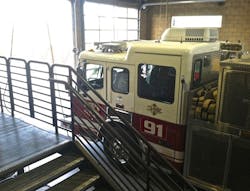Touring Fire Stations to Develop Ideas for Your Next Project
Congratulations, your department is moving forward with building a new firehouse. How do you know what you need? How do you gather information on current firehouse design? One of the best ways is to look at other departments.
First, tour other agencies nearby. Secondly, tour wherever you travel. I’ve been in almost 50 firehouses in 45 cities in 11 states and six foreign countries. Third, go to a fire department conference. Usually there is an organized tour of a new firehouse nearby. Even if there is not an organized tour, ask about the newest firehouse in the area.
Here is your checklist for a successful tour: camera with lots of memory and a full battery; tape measure; small notebook; lots of questions; open ears and most importantly, an open mind. You are visiting the station to learn, not critique.
We can’t agree on the color of the trucks, so we are certainly not going to agree on the architecture and layout of the building. You may like an old-style exterior. You might like modern buildings. I don’t argue for either exterior. The exterior architecture is politically important though. It may help you with funding. It is the architect’s job to turn the collection of interior spaces into a functional firehouse and give it the exterior look you need.
Regardless of the exterior, your first focus should be on the interior. The interior of a fire station is a machine and it needs to function.
Contrary to popular opinion, the kitchen is not the heart of the firehouse. The heart is the apparatus bay. It is a very technical space. Pay particular attention to what equipment and functional spaces line the walls and observe what equipment is hanging from the ceiling.
If this is an organized tour, do not just listen to the people who were responsible for the design and construction. Talk to the crews who work in the building. Sometimes their stories do not match. I went on a tour once and the local firefighters at the tail end of the group were shaking their heads “No” to things the officer leading the tour was saying.
Determine if the building works as advertised. Ask what they would re-design if they could. Don’t let your questions imply criticism. “Why did you do that?” could shut down a conversation quickly. Framing a question with an “I don’t understand….” sets the stage for dialogue.
If you see an unusual floor plan, there must be a story behind it.
This site was so tight the apparatus bay is angled back towards the living space. The truck could not make a 90º turn from the driveway to the garage doors.
Take pictures of everything. Shoot with the tape measure to give a sense of scale of what you are photographing. If you see a hinge you like, take a picture. If you like the brand of any of the furniture, shoot it. Take pictures of every room sign you see and that way you will have a record without writing anything down.
While at the Station Style Conference in Phoenix several years ago, we toured Phoenix Fire Station 13. It was built on a challenging, sloping site. As a result I saw my first split-level firehouse. The apparatus bay was about five feet lower than the living space. It was the only way they could get the entire building on the site.
Another reason to tour fire stations is vindication. I was responsible for a firehouse being built on a federally recognized flood plain. We had to address the potential of future flooding. I had the architects split the building with the living space raised above the flood level and the apparatus bay at the lower level. The idea was to see the minimum equipment that needed to be on the floor and would be lost in a flood. Walking into Station 13 vindicated my concept.
In the design and construction of your firehouse, furniture, fixtures and equipment are important. It is usually called “F, F & E” for short. Again, lots of pictures, lots of notes and ask lots of questions. If you see a particular piece of equipment you like, take a picture of the manufacturer’s label. It will give you a way to research the product.
Two warnings: new equipment may not have a track record to gauge its reliability or you may be far enough away from home that the equipment may be regional; meaning parts and repairs would not be readily available.
What kind of kitchen appliances do they have, residential or commercial? What brand of turnout lockers do they use? Will they work for you? Where did you get that brass pole?
What materials did they use? Firehouse surfaces have to be durable. Look at the floors, walls, ceilings, countertops, cabinets and doors. If something catches your eye, ask about it.
If you see something you do not have in your firehouse, ask about it. For example, in Kansas City I saw these lights in the hallways. Great idea for nighttime path of travel lighting.
Lastly, ask about the costs too. You may need to justify the new product you are now in love with. Good hunting!
JIM McCLURE spent a third of his 29-year career as the lead on the design and construction of 11 new firehouses and numerous remodels in California. He knows how the firehouse functions, what breaks and what doesn’t. McClure shares the information with firefighters and architects that is needed to build a functional, durable firehouse. He can be contacted at: www.firehousedesignandconstruction.com.
